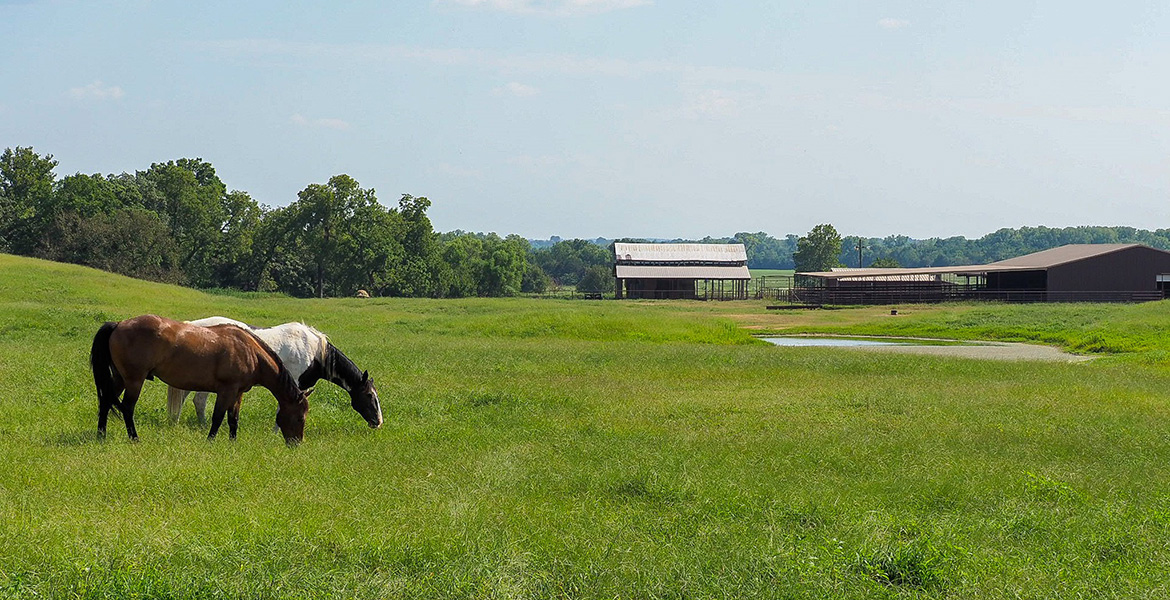
Landscaping for horses requires thoughtful planning
Thursday, August 27, 2020
Appearance, functionality and animal safety are important factors for horse owners to consider as they change the trees and other plants in an equine’s environment, Oklahoma State University Extension experts said.
“People are used to just getting on the internet and looking things up, but information about what plants are acceptable around horses can be very confusing and often seemingly contradictory,” said Brad Secraw, Cleveland County Extension agricultural educator.
For example, in Cleveland County where urban and rural lifestyles meet, a horse owner may want to provide privacy screening to keep animals out of sight of neighbors. There are several elements to weigh, among them whether the plants grow well in Oklahoma, whether they lose their foliage during winter months and, most importantly, whether they are toxic to horses.
“I recommend contacting your local county agricultural or horticultural Extension educator to see if he or she can’t make an on-site visit,” said Kris Hiney, OSU Extension equine specialist. “General recommendations a person might get off the internet are a good starting point and can help the property owner better understand input costs and investment of time, energy and effort. However, there are a great many variables that need to be considered with each specific site.”
For privacy, the following plants are good possibilities for Oklahoma horse operations:
- Eastern redcedar – An invasive plant seen far and wide across Oklahoma but able to maintain its greenery in colder weather. Never plant seed-bearers, often referred to as females. Tree nursery operators should know the difference between sex types.
- Arborvitae – Similar to a cedar tree but not as competitive with other plants in terms of soil nutrient and water use. It is a thick and tall evergreen when fully grown.
- Crepe myrtle – Scenic flowers will bloom mid- to late-summer. The loss of leaves in winter may limit the screening effect.
- Forsythia – This selection has showy yellow flowers in the spring, and while it loses leaves in winter, the plant has a thick branching structure. However, it only grows to about 5 feet tall.
- Rose of Sharon – Nice flowers and it becomes more treelike as the plant ages. The major drawback is that it loses leaves in winter.
- Russian olive – This attractive option is a light silvery green color. Unfortunately, it has thorns and loses its foliage in the winter.
- Star magnolia – Flowers in the spring but loses its leaves in the winter.
- Southern magnolia – An attractive and functional selection for anyone not in a hurry. The drawback is that a group of such trees would likely take 20 or more years to effectively screen off an area.
The listed plants are not poisonous to horses and other equines. They should be planted 15-20 feet from the fence line and spaced from one another according to planting recommendations. Cost will vary according to planting size.
“I would not recommend Leyland or Arizona cypress; the trees are great for a while, but then issues such as Seiridium and Botryosphaeria canker can become an issue,” said Jen Olson, OSU Extension diagnostician with the university’s Plant Disease and Insect Diagnostic Laboratory. “Property owners with horses might want to consider one of the improved, upright junipers such as Spartan or Taylor.”
Just because a tree might be a good candidate for privacy screening does not automatically make it a desirable choice for shade, where potential toxicity issues become more of a concern. Good pasture will keep a horse happily munching on grass, but poor-quality forage can lead to inquisitive equines looking for more palatable food options. In drylot situations, a bored horse may chow down on anything that looks interesting.
Southern magnolia, cottonwood, American sycamore and hackberry are useful shade options. Elm trees have potential, but some varieties are susceptible to disease and therefore may not be the best monetary investment. Certain American elms – the Princeton and Prairie Expedition varieties, both favorites of Secraw – are disease-resistant and have been identified as “Oklahoma Proven” under that plant evaluation and marketing program coordinated by faculty in in OSU’s Department of Horticulture and Landscape Architecture.
“Don’t confuse American sycamore with acer pseudoplatanus, a type of maple that is also called sycamore in England and has been connected to atypical myopathy in horses,” he said. “If your internet source is from England, it’s easy to become confused because of language differences.”
The acorns of oak trees are dangerous to horses. Never plant a maple tree in a horse pasture or lot. For barns and fence lines, err on the side of safety and keep all plants out of reach.
For more information about research-based horse management and horticultural practices, consult OSU Extension fact sheets, available online and through all county Extension offices.
OSU Extension is one of two state agencies administered by the university’s Division of Agricultural Sciences and Natural Resources and is a key part of OSU’s state and federally mandated teaching, research and Extension land-grant mission.
MEDIA CONTACT: Donald Stotts | Agricultural Communications Services | 405-744-4079 | donald.stotts@okstate.edu
